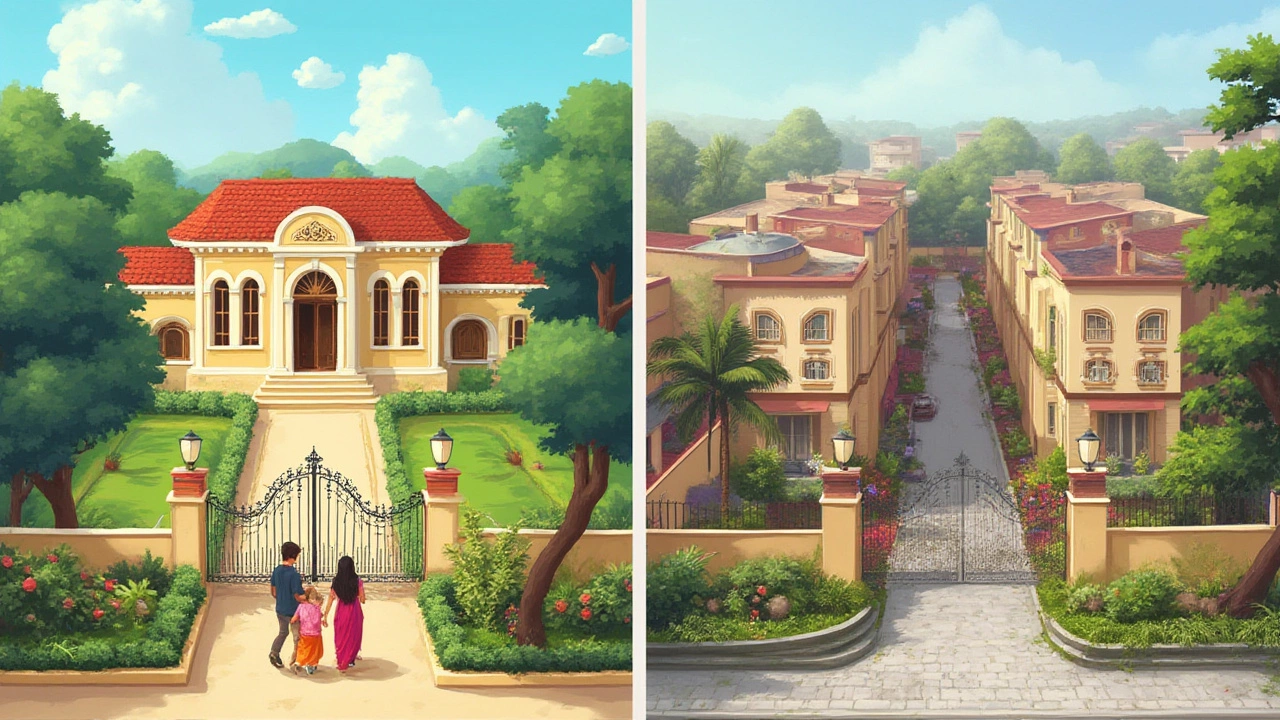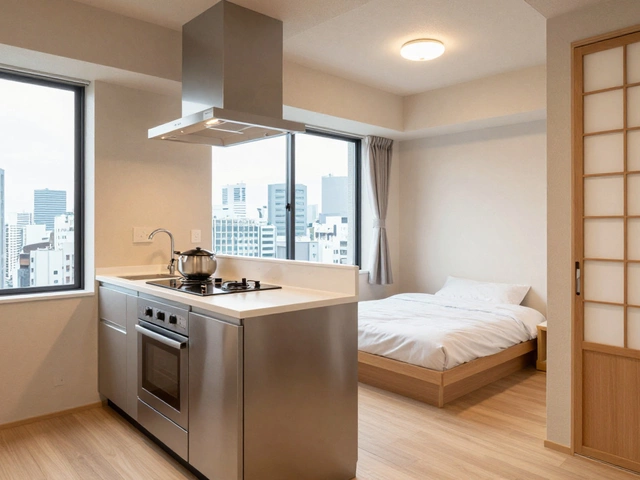Ever sat down at a party and realized people talk about villas and townhouses like they’re two sides of the same coin? Next thing you know, someone throws out words like “luxury,” “privacy,” or “community living,” and suddenly, the line between the two gets fuzzy. So, let’s bust the myths and really figure out what a villa is vs. a townhouse. If you’re in the market for one of these or just plain curious, knowing what you’re actually paying for matters.
Villa vs Townhouse: Getting the Basics Straight
The word “villa” brings to mind images of sprawling properties on the coast of Spain or maybe one of those fancy places in Bali with a pool just for you. A villa is more than just an expensive house. Traditionally, a villa is a standalone home sitting on its own plot of land. It comes with private gardens, sometimes a pool, and usually a noticeable gap between you and your neighbor. Privacy is the name of the game. You’ll find these in suburbs and upmarket areas, but also popping up in vacation hot spots. Because a villa is detached, you control your own four walls—no one’s sharing a wall with you, which means fewer neighborly noises.
On the flip side, a townhouse is that tall, narrow home attached on at least one side to another similar house. Usually, townhouses come in rows—think of those classic brick homes lined up in Chicago or London. They have multiple floors stacked one on top of another, with direct street access. You might have a small backyard and sometimes even a little porch or balcony. But don’t expect acres of land or total isolation. Townhouses are designed to fit more homes into less space, which is why they’re big in cities or suburbs where land’s at a premium.
Here’s a quick breakdown:
- Villas: Standalone, often larger, private yard, more expensive, found in luxury or resort areas, more privacy.
- Townhouses: Attached on one or both sides, multiple floors, less land, closer neighbors, usually more affordable.
Now, let’s talk about ownership. Buying a villa means you typically own both the building and the land it’s on (that’s called “freehold” in real estate speak). With a townhouse, you usually own the inside of your unit and maybe the patch of land out back, but the wider development (like communal gardens, driveways, and walls) is shared with your neighbors. That means there’s often a homeowners’ association (HOA) involved with townhouses—you’ll pay monthly fees for things like maintenance, landscaping, and security.
Some real-world examples: While visiting Italy, I remember Amara (my wife) being blown away by farm-style villas outside Florence—stone buildings, acres of olive trees, absolute silence except for cicadas. Meanwhile, in our own city, our friends bought a three-story townhouse. They gave up yard size for an easier commute to work downtown. Two different worlds!
One more thing: Townhouses usually have smaller price tags than villas. It isn’t just the structure—it’s the land. In almost every country, land is gold. When you buy a villa, you’re snapping up a chunk of earth along with your home. With a townhouse, you’re investing in the space inside, but the outdoor area is much more compact and often shared.

Lifestyle and Living: What’s It Actually Like?
Let’s be real—choosing between a villa and a townhouse isn’t just about money. It’s about how you want to live. Imagine you’re raising a family (like me, chasing after Elara in our backyard), and you want room for your kid to run wild, host summer BBQs, maybe build a treehouse one day. That sounds like a villa to me. You set your own rules for your property, and nobody tells you what color to paint your front door.
But not everyone wants to mow a massive lawn or worry about pool maintenance. Townhouses are about convenience. If I were single or just starting out or even downsizing with Amara, the idea of parking the car, walking straight into the kitchen, and having a community coffee shop two doors away would appeal. City centers, happening suburbs—this is townhouse territory. You’ll have neighbors to borrow sugar from or complain about trash pickup to. Sometimes, a tight-knit row of homes leads to spontaneous street parties and communal Halloween fun with the kids. Social life built in.
Noise and privacy are a real thing to think about. With a villa, that late-night movie marathon or backyard game of cricket doesn’t earn dirty looks because there’s a real distance between you and the next house. Townhouses? Well, you need to be on friendlier terms. Shared walls mean you’ll probably know when the neighbors are arguing or when their dog gets into the peanut butter.
What about security? For villas, you get control. Want cameras, higher fences, or a guard dog? Go for it, as long as the local rules allow. But you’re also the one responsible if some sneaky raccoon (or burglar) comes calling. Townhouse communities usually offer shared security—gated entrances, patrols, shared camera systems—which is nice if you travel or don’t want to install your own tech.
A common myth: “Villas are too isolated.” That’s not true everywhere. While you do have more space between you and your neighbor, newer villa communities may have clubhouses, pools, and even organized BBQ nights, so you can still feel part of a neighborhood without sacrificing privacy.
And then there’s maintenance. Villas give you freedom, but also all the chores. Roof leaks? Lawn growing out of control? Pool turning green? All on you. A townhouse’s HOA covers the outside repairs, shared gardens, and sometimes trash collection. Monthly fees can add up, but some people would rather pay and not worry about repainting the fence every year.
Energy bills also come into play. Villas, with more exterior walls and bigger spaces, suck up more heating and cooling. Townhouses, buffered by your neighbors’ homes on each side, can be more efficient. If you care about the environment—or just hate big utility bills—that might sway you.
Pets? Villas are paradise for dogs, cats, and even the occasional pet rabbit. With townhouses, pet rules depend on the community. Some have strict limits on breeds or numbers, so read the fine print.
If you want to renovate or expand, villas give you room to get creative. Dreaming of a new sunroom, bigger patio, or even a wine cellar? Knock yourself out (subject to planning rules). Townhouses are less flexible. Changes need HOA approval, and there’s only so much you can add without upsetting the whole row.

Investment, Resale, and the Hidden Details
Sure, you fall in love with a home, but don’t forget the long game: Is your villa or townhouse a good investment? Historically, villas hold their value better, especially in stable markets where land is scarce. If your villa’s in a hot location—near cool schools, parks, lakes, or the beach—you’ve got a strong asset. Townhouses are popular for first-time buyers, busy professionals, and for rentals. They might cost less up front, but their price and rent growth can be more stable in fast-changing neighborhoods.
That being said, not all villas are gold mines. Sprawling homes far outside the city, without good transport or shopping, can languish on the market. Townhouses are trendy in areas where city space is shrinking or new fashion districts emerge, so don’t count them out for appreciation. Some cities (like Toronto and Sydney) have seen townhouses sell like hotcakes when developers build them near train lines and trendy cafes.
One fact: Resale times are usually quicker for townhouses in city centers and for villas in established, desirable suburbs. Villas with lots of customizations, quirky layouts, or dated décor can be harder to sell. Townhouses are more “what you see is what you get,” so staging matters but extreme makeovers don’t move the needle as much.
Watch out for costs hiding in plain sight. With villas, the land taxes can be steep, especially if your garden sprawls. Pool maintenance, landscaping, insurance—these add up. With townhouses, those monthly HOA fees are sometimes more than you’d guess, and they can go up each year. Special assessments (those surprise charges when the roof or fencing needs repairs for the whole development) are a reality in many townhouse communities. Always, always read the HOA handbook before you sign. Know what’s covered, what isn’t, how often fees increase, and if any major upgrades are coming soon.
If you’re thinking rental returns, villas attract longer-term tenants—families, expats, folks looking for luxury or privacy. Townhouses tend to appeal to young professionals, small families, or people wanting a short commute and little hassle. Townhouses are easier to rent quickly, but villas command higher rents and more stable tenants if you nail the location.
Here’s a tip: Pay attention to insurance. Insuring a villa costs more, but you cover every bit of property risk. Townhouses, because of shared structures and sometimes HOA insurance, usually come with cheaper individual premiums, but check what the master policy covers. A recent home insurance report found that villa insurance claims for flooding or storm damage are higher, because there’s more to cover and repair costs shoot up outside city limits.
And one last thing—future-proof your choice. Urban areas are changing fast, but so are lifestyles. If you want to grow a family, run a business from home, or just need peace and green space, a villa could fit the bill, even if it costs more up front. If you want city life, less maintenance, and maybe more social buzz, a townhouse keeps things simple.
Guess what’s non-negotiable? Always tour both. There’s a world of difference between seeing glossy photos and actually walking through a space with your own feet. Bring a tape measure, ask about the neighbors, sniff for any musty basement smells, and picture where you’d put your favorite chair or your kid’s soccer goal. And remember—no choice is permanent. Life changes. What fits today may not fit in five years. The key is knowing what you’re getting into and picking the one that feels like home.





